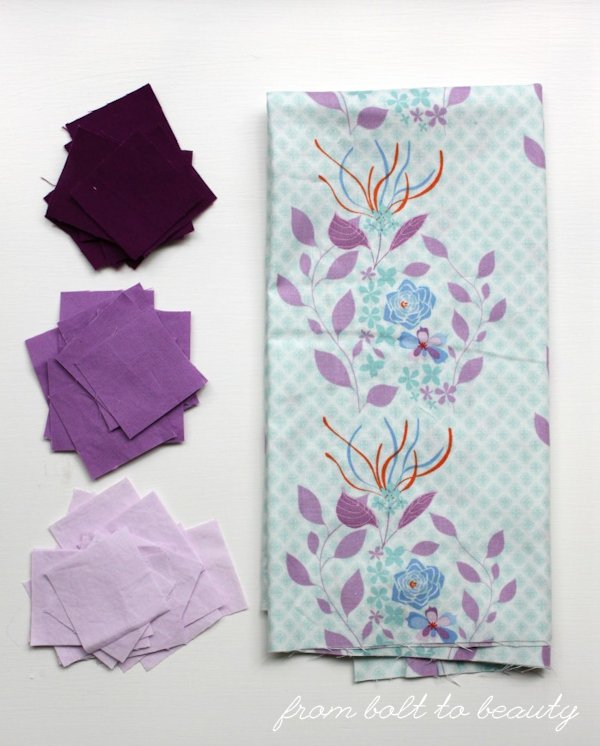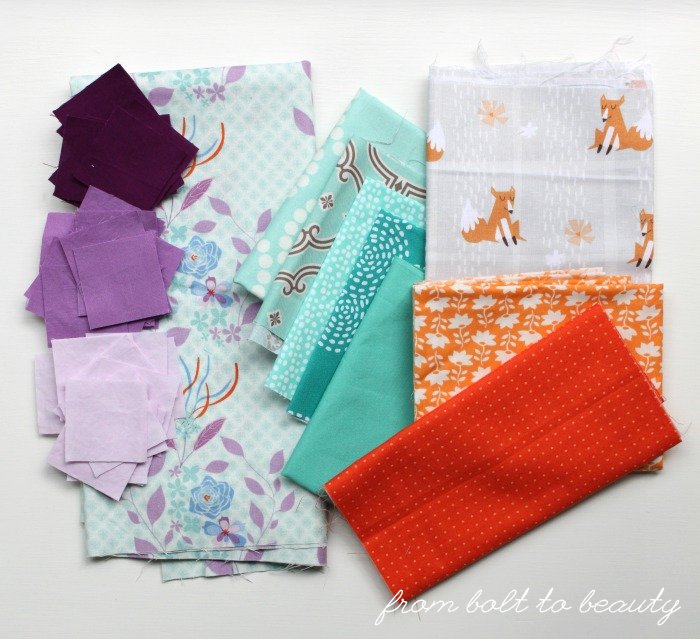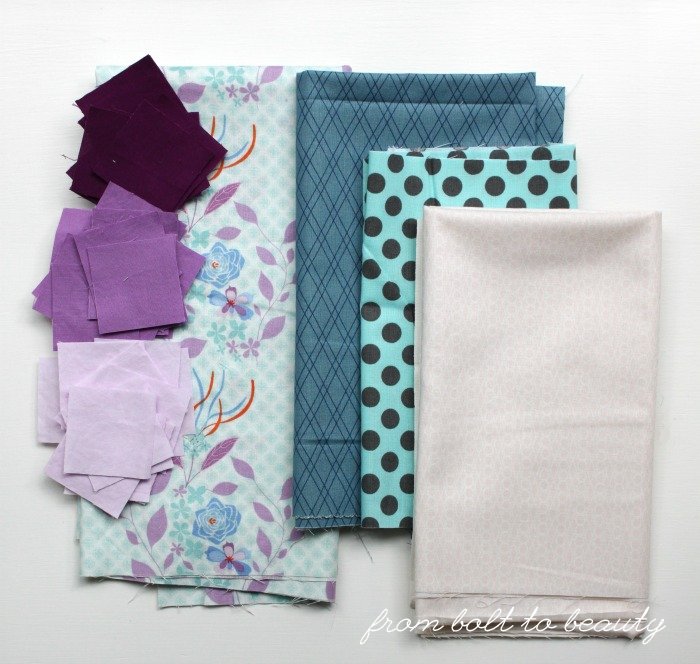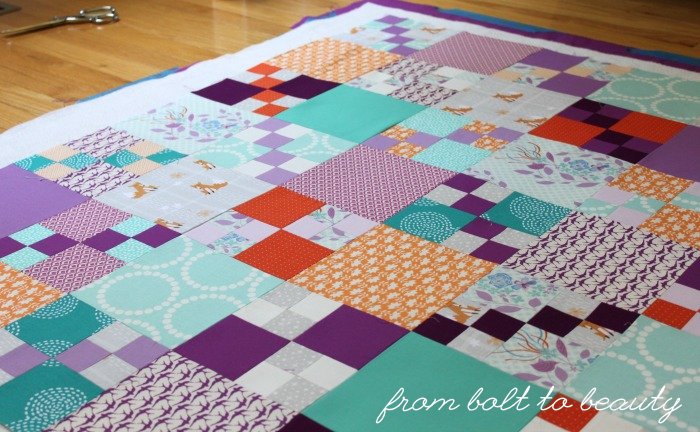As a new quilter choosing fabrics, I went with my gut. The more quilts I make, though, the more I realize the process isn’t as simple as “I used these fabrics because they’re pretty together.”
I thought it would be interesting to look at the criteria I use when pulling fabric for a new project and then see how my selections play out in a finished quilt top. If you find yourself following the same—or different!—criteria, I’d love to hear about it in the comments. Also, if you like this kind of content, let me know. It’s fun to write posts like this and even more fun if there are readers who like to read them.
When I’m planning the fabric for a quilt top, four key factors pop in my mind:
Palette: This is the colors I choose to use in a quilt. Quilters can find color inspiration everywhere. I like to start with an interesting fabric and work from there.
Scale: This is the size of the design elements of a fabric. For some quilts, I might choose all small-scale designs or all large-scale designs. Or I might purposefully pick a combination. Each approach produces a different effect.
Volume: This refers to the intensity of color in the fabrics. Like scale, I might focus on one end of the spectrum or the other—that is, a bunch of high-volume fabrics or low-volume ones—or I might use a combination.
Overall feel: This is the result I’m ultimately trying to achieve. I may want to create a bold, modern, masculine quilt. Or I may be going for something soft and ethereal. Whatever the intended effect, it influences the palette, scale, and volume decisions I need to make.
The Beginning of My Foxy Quilt
After paper piecing Grape Fizz, I had a bunch of 2” purple squares left over. I paired them with an older print—Hothouse Flowers, by Mo Bedell—and thought I had the start of something interesting.
I decided to sew a Penny Patch Quilt. I’ve been meaning to make this pattern, by Rachel Hauser, for a few years. It’s a great design because it calls for squares in three sizes: 2”, 3½”, and 6½”. With these sizes in mind, I could cull through my yardage and my scrap bin to come up with the right combination of fabrics.
Fleshing out the Fabric Pull
The Hothouse Flowers print was a great starting point. It’s feminine and whimsical, and has a bunch of different colors in it. I fleshed out the palette for a little-girl quilt from that fabric. To the floral yardage and purple scraps, I added some teals, a novelty fox print (Wonderful Woodlands by Arrolynn Weiderhold for Wilmington Prints), and some oranges.
As I was assembling my fabric pull, I was looking for patterns that varied in scale and volume. That contrast creates interest for me. That’s why I chose solids and patterned fabrics, low volumes (like the foxes) and high volumes (like the orange Zen Chic dots), different kinds of geometrics (some predictable and uniform, like the Lizzy House pearls, and some less so, like the dashed concentric circles).
I started cutting and laying out the blocks. I knew the zingers in the mix were the deepest purple scraps and those orange Zen Chic dots, so I only used them for 2” and 3½” squares. They were so eye-catching that they could have overwhelmed the quilt in 6½” chunks.
Scrapping the Rejects
I wanted the final quilt to be feminine and youthful with a softness to it, and not all of my fabrics made the cut. Ultimately, the second teal from the top in the picture above wasn’t working. I thought the contrast between the pale teal and rigid design could overshadow the real stars: the Hothouse Flowers print and fox fabric.
The pieces on the right, below, were also edited out ...
The blue crosshatch has a vintage feel to it, which I wasn’t going for in this project, and against all the purples, the color just seemed boring.
The blue and brown dot, with its sharp contrast and strong geometry, would have upstaged some of the other fabrics and undermined that sense of softness I was going for.
I thought the pale-pink Lizzy House jewels could work with the other low volumes, but it was too pink to play with the purples.
The Final Reveal?
I am still quilting this throw, so a full reveal will come in the next week or so. But here’s a sneak peek of it when I was basting. I’m really pleased with the balance of colors and patterns that I was able to achieve. And did I mention this fabric was all from my stash? Woo hoo!
What does your fabric-selection process look like? What factors do you consider?
Linking up to Let’s Bee Social and Needle and Thread Thursday ...





Your final product was definitely worth the time to audition fabrics to get just the right balance. Very pretty!
ReplyDeleteYes, i like posts like this! It's interesting to see how quilters make decisions. Love the finished quilt top
ReplyDeleteWhat a fun quilt! Thanks for the inspiration and link to Rachel's Quilt along. I've been following her for a while, but I guess I haven't gone far enough in her archives to find this. I'm always looking for scrappy quilts with great visual impact to use up some scraps. Sewing one sized squares together is just too boring..I enjoyed your post because I love seeing the process. It's very similar to how I choose colors... Usually pulling WAY more fabrics than I will use, but I need to see them all!
ReplyDeleteI'm going to give this one a try... when I finish up some UFOs and Planned Projects!
Hi, Michelle. Just found your blog and like what I see. I, too, enjoy process posts. You may not want to hear this, but your approach to pulling fabric has been done by traditional quilters for years! Just shows that good art is good art, regardless of the medium. Thanks for exposing me to Penny Patch quilts.
ReplyDeleteI don't doubt that traditional and modern quilters alike take these things into consideration! There's something helpful in breaking down the steps, though. It's like being at a quilting retreat, peeking over a friend's shoulder, and asking her why she's doing something one way instead of another. We can grow faster as quilters when we share stuff like this. : )
DeleteThanks for taking us through your process. This is such a useful post especially for all the people who say they have trouble choosing fabrics! Rock on, Michelle!
ReplyDeleteYour colors are great - I would never have thought to add the orange but it looks so nice- thanks for sharing
ReplyDeleteI love your posts! It makes me think a little more about selecting fabrics. While I tend to shy away from prints...Okay, I run from prints...its always nice to see how others make their decisions. I still agonize over fabric selections, and most likely always will.
ReplyDeleteI love posts like this, it helps beginners like me learn the tricks of the trade! :) I still bumble about some with fabric selection. It's definitely the most stressful part of quilting for me. Lol.
ReplyDeleteI have NO IDEA how I pull fabrics, haha. I mean, I understand all of these concepts: scale, color, varying, mixing up the color wheel, etc. But somehow, I don't think about these things when making fabric calls. Weird, right? (Maybe I SHOULD!!) :)
ReplyDeleteThis is the kind of content I need and would really appreciate more like it! Thanks for your help.
ReplyDeleteThanks for showing us your process. I think mine is very similar. I start with one piece and grow. Sometimes removing a fabric after others are added. Making sure the star fabric remains the star and each piece knows its place...background, filler, contrast, interest, whatever.
ReplyDeleteI almost always consider the person I am making the quilt for too. I find it hard to make a quilt without a personality in mind.
Although I'm aware of all the elements you listed, I'm not nearly as organized or conscious of my decisions, but seeing how your quilt came together, I see that I need to be! I do tend to use binoculars (as reducing glasses), and photos in grayscale and thumbnails as these all help me see how fabrics work together in ways that I might miss by relying on the overcompensating effects of my vision, if that makes any sense. I do like these kinds of posts!
ReplyDeleteFabric selection is a major hurdle for me....I struggle with seeing how fabrics will work together. Just like with your pull, as soon as I saw the oranges I was like "why did she add those?" Then I see the top and it looks fabulous and the oranges work perfectly. I always enjoy these types of posts so keep them coming. I think I need MUCH more practice, so I guess I'll just have to make MANY more quilts!! :)
ReplyDeleteA lovely quilt, and a great way to power through your scraps & stash! I enjoyed reading about your processes. I'm sure choosing my fabrics has got better over time & with practise, and lately I've tried starting out with a common link like a focus fabric or colour story in mind.
ReplyDeleteYes, give us the details, the education; it's why I read blogs! As you said in a reply above: "We can grow faster as quilters when we share stuff like this." Yes, please continue. And BTW, I love your choices--and reasoning for them--for this quilt.
ReplyDeleteNice post and lovely modern looking project
ReplyDeleteWhat a great post! I loved seeing how you analyzed the various fabrics and the hows and whys of what you edited out. Seeing the sneak peak of how it all came together was so surprising to me - I was very skeptical when you added the orange but it all seems to work. I don't really pick fabrics with purpose. I tend to stay within a fabric line and just add a coordinating solid. I need to push that boundary of pulling fabrics with purpose. Thank you so much for posting this.
ReplyDeleteGreat post ... I'd love to see more. I couldn't visualize how all the fabrics would come together (thats MY problem) but the finished quilt top definitely works and I love the fabric together. Thanks for sharing.
ReplyDeleteGreat post ... I'd love to see more. I couldn't visualize how all the fabrics would come together (thats MY problem) but the finished quilt top definitely works and I love the fabric together. Thanks for sharing.
ReplyDeleteSuch an interesting post! I appreciated hearing about how you chose the fabrics for this quilt, but also the link to the pattern. I've been making 4 patches out of my 2 1/2 inch scraps all year in a rainbow of colors without much of an idea of what I was going to do with them. Something like your Penny Patch quilt could work!
ReplyDeleteI love Penny Patch! That pattern never gets old. The colors you chose worked out great. I still go with my gut, but feel as though how daring I am with the combinations have evolved. Now I will try combinations that I wouldn't think of when I started quilting.
ReplyDeleteGreat pattern and fabric pull. Thanks so much for taking us through the process of selecting the fabrics.
ReplyDeleteGreat post! I love reading about someone else's process. I enjoy picking out fabrics, but I also find the process intimidating sometimes as I'm still not truly confident in my colour choices. I think it's because I still have trouble envisioning how the fabrics will look together after they're cut up and sewn back together.
ReplyDeleteGreat to see your process. I often get stuck at scale and think I have to have large and small, and on pattern I think that I have to have a stripe and check.I have to remember it is about creating the effect you want.
ReplyDeleteI love your process, it really does help to have someone break it down for you. Awesome post with great content!
ReplyDelete